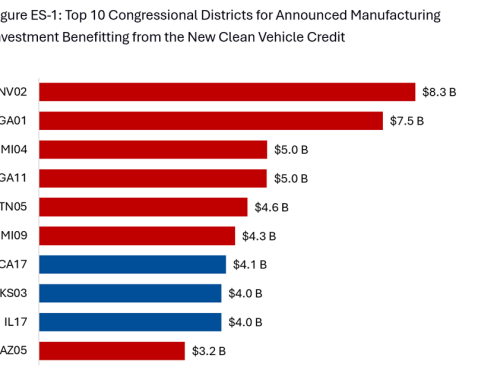
The Inflation Reduction Act (IRA) passed in the House on Friday last week. It marks an enormous moment for the climate movement and the largest investment in climate action ever.
Between the initial draft and the final passage, it doesn’t appear there were any edits to EV elements other than a specification of where the USPS funding should go.
There are opportunities in the Act for EVs as well as challenges. We tracked $105.8 billion in funding for which EVs are eligible including $51 billion in tax credits (per Congressional Budget Office estimates). You can see our full breakdown here.
EV Tax Credits Will Shake Up the EV Market
To recap, the existing $7,500 existing tax credit has been renamed and reshaped. The 200,000-vehicle cap is lifted (meaning Tesla, GM and Toyota are back) and the credit is now split in two parts:
$3,750 if the battery is constructed with critical minerals extracted in the United States or a country the United States has a free trade agreement with or recycled in North America. This is based on a percentage of components that will increase over time starting with 40 percent in 2023.
$3,750 if the vehicle is made with a battery manufactured or assembled in North America. This is based on a percentage of the value of components that will increase over time starting with 50 percent in 2023.
Beginning in 2024 for the battery requirement and 2025 for the critical mineral requirement, no percentage of the material can be extracted or processed in or by an entity of foreign concern (i.e. Russia or China). Lastly, final assembly must take place in North America for the vehicle to be eligible.
The credits will also quickly shift dynamics for buyers and automakers. We saw a flurry of activity from Rivian last week to try to lock in the existing credit for their customers before it was passed in the House. Under the revised tax credit, some Rivian vehicles will no longer qualify as they are above the new MSRP cap.
Here is a wrap of how the credit will impact various automakers. According to the Alliance for Automotive Innovation, “there are 72 EV models currently available for purchase in the United States including battery, plug-in hybrid and fuel cell electric vehicles. Seventy percent of those EVs would immediately become ineligible when the bill passes and none would qualify for the full credit when additional sourcing requirements go into effect.”
It is unclear how many vehicles will be eligible for the credit. There are also questions, to be answered by regulators, about what the restrictions look like in practice.
Development of domestic battery manufacturing is well underway, which could make some EVs eligible for at least part of the tax credit in the longer term
Given the domestic (plus Mexico and Canada) requirements in the Act, Automakers will have to shift operations to the U.S. in order to qualify for the credits. This may speed up existing commitments. Automakers have already committed $32.5 billion to manufacture batteries in the United States, per the Automakers Dashboard. Note that more than half of that production will not come online until 2024. To support these efforts, the IRA includes a tax credit for advanced manufacturing estimated at $30 billion, $40 billion in loan authority for DOE, and $2 billion in grants for converting manufacturing facilities to produce EVs.
Equity is centered in the tax credits
The tax credit transfer mechanism will allow buyers to access the credit at the point of sale. There are two benefits particularly for low-income buyers, first that people do not need to wait to get the credit and the second is that those without a tax bill will still qualify for the credit, opening it up to lower income households. That’s a big deal for equity and convenience, though we don’t know exactly how much of the $7,500 will be passed on to consumers. Note that all of this is moot if no vehicles qualify for the credit.
Additionally, the used EV tax credit will support low- and moderate-income households that cannot afford to buy a new EV, buy a used EV (also at the point of sale). For the used vehicle tax credit, the following restrictions apply:
-
Purchase price of less than $25,000 and the credit will cover the lesser of $4,000 or 30 percent of the sale price
-
Income cap of $150,000 for joint filing and $75,000 for individual
-
Purchased through a dealer
-
Credit starts in 2023, transferability (that is where the individual can get the credit upfront) starts in 2024
Most of the IRA funding for EVs comes from sources other than the clean vehicle credit
There is $97 billion in the IRA that could support transportation electrification beyond the clean vehicle tax credit including:
-
$3 billion for the USPS to electrify fleets and $1 billion for Clean Heavy-Duty Vehicles, collectively more than all public funding for MDHD EVs to date ($3 billion).
-
Tax credits for used vehicles, MDHD vehicles, charging stations, and EV manufacturing.
-
Important funding that could support EVs including the $27 billion Greenhouse Gas Reduction Fund and $5 billion Climate Pollution Reduction Grants.
Elsewhere, the CHIPS Act signed into law by President Biden last week will support the IRA with considerable research including up to $67 billion “towards accelerating the growth of zero-carbon industries and conducting climate-relevant research”, according to research from RMI.

